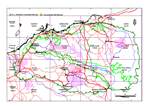Botanical name
Acacia ? citrinoviridis x tumida var. pilbarensis
Description
Trees to 3 m tall, the canopy spreading and dense. Bark dark grey. Branchlets glabrous (except on new shoots). New shoots densely clothed with iridescent, citron yellow hairs which soon age silvery white. Phyllodes falcately recurved, narrowly elliptic, 9-13 cm long, 9-12 (-15) mm wide, thinly coriaceous, not rigid, the young and adolescent phyllodes sericeous (due to dense layer of short, straight, appressed hairs) but becoming glabrous with age, presumably green; parallel longitudinal nerves numerous, fine and close together, very few anastomosing, the central nerve more pronounced than the rest, marginal nerves discrete, narrow and yellow; apex acute to acuminate and not spiny. Inflorescences mostly short racemes 5-15 mm long, the axes densely silvery appressed -hairy and normally growing out to a new shoot at apex; spikes 20-30 mm long, the flowers densely arranged; peduncles 5-10 mm long, densely appressed white hairy; receptacle densely clothed with pale yellow, soft, spreading hairs. Flowers 5-merous; sepals ±free. Pods unknown.
Characteristic features
Iridescent pale yellow new growth. Phyllodes falcate, mostly 9-13 cm long and 9-12 mm wide, finely multi-nerved. Inflorescences short racemes (5-15 mm long) that grow out at apex; spikes 20-30 mm long; receptacles with dense, pale yellow, soft spreading-hairy; peduncles 5-10 mm long.
Distribution and ecology
Known from only a single flowering specimen that was collected in 1999 from near Cane River Station, 80 km southeast of Onslow, northwest Western Australia. The plant grew in hard, red clay along a watercourse on a recently burnt spinifex plain.
Flowering and fruiting period
The plant was in full flower in late May.
Taxonomy
Without having seen this entity in the field ourselves it is not possible to know with certainty whether or not it is an aberrant form of A. citrinoviridis or a hybrid between this species and A. tumida var. pilbarensis. However, judging from morphological criteria it may well be a hybrid because it resembles A. citrinoviridis in most characters except that its inflorescences are arranged in racemes which is a characteristic of A. tumida var. pilbarensis. It is not known if the putative parents occur where this plant was found, however, they do occur within the same general region but are not particularly common there.
Conservation status
There is insufficient information at present concerning this entity to justify including it on the Department of Environment and Conservation's Declared Rare and Priority Flora List.


